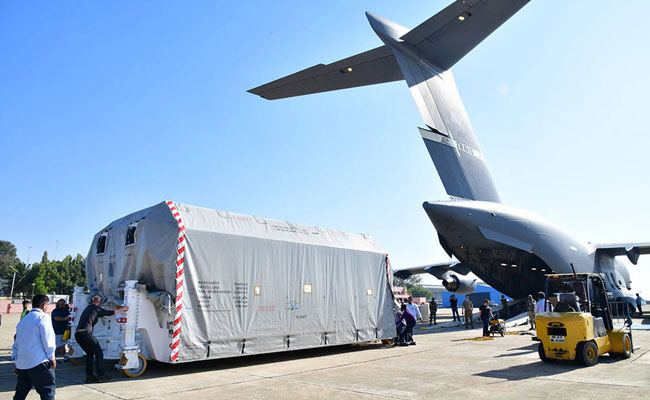The Indian Space Research Organization (ISRO) will launch NISAR in 2024, which will deploy the most advanced radar system ever on a NASA science mission. NASA-ISRO Synthetic Aperture Radar (NISAR) will observe nearly all of Earth’s land and ice surfaces twice every 12 days, measuring movements in extremely fine detail. It will also cover forests and agriculture regions in its survey to demonstrate to scientists how carbon exchange between plants and the atmosphere occurs.
Mission NISAR was envisioned by NASA and ISRO eight years ago, in 2014, with an aim to powerfully demonstrate the capability of radar as a science tool to help Scientists study Earth's dynamic land and ice surfaces in detail. NISAR will be the first satellite with a mission to use two different radar frequencies (L-band and S-band) on the science payload to measure changes in our planet's surface less than a centimetre. The payload of NISAR, set to launch as a part of the NASA science mission will include the most sophisticated radar system (L-band and S-band) ever launched. This system will have the biggest radar antenna of its kind, which will be nearly 40 feet (12 meters) in diameter and drum-shaped with a wire mesh reflector. The antenna will extend from a 30-foot (9-meter) boom.
The dual-frequency imaging radar satellite that uses Synthetic Aperture Radar (SAR) to produce high-resolution images capable of penetrating clouds can collect data day and night regardless of weather conditions. This provides the mission an opportunity to observe wide changes ranging from the flow rates of glaciers and ice sheets to the influences of earthquakes and volcanoes. The NISAR will be loaded with two fully capable synthetic aperture radar instruments: NASA’s 24 cm-wavelength L-band Synthetic Aperture Radar (L-SAR) and a 10-cm-wavelength S-band Synthetic Aperture Radar (S-SAR) provided by ISRO. NISAR has a 240 km swath, 7 m resolution along track and 2-8 m resolution cross-track (depending on mode).
In addition, NASA is furnishing several essential components for this project, including the radar reflector antenna, the deployable boom, a high-speed communication subsystem for scientific data, GPS receivers, a reliable solid-state recorder, and the payload data subsystem.
Along with the S-band Synthetic Aperture Radar (SAR), the Indian Space Research Organization (ISRO) is furnishing the spacecraft bus and launch vehicle, as well as the corresponding launch services and satellite mission operations. In March 2021, the S-band radar was constructed by ISRO and transported to the Jet Propulsion Laboratory (JPL) of NASA.
For a period of two years, engineers dedicated a significant amount of time to integrate the S-band radar supplied by ISRO into the instrument with the L-band system constructed by JPL, known as Science Payload, followed by a series of tests to confirm their compatibility. Once the compatibility test was confirmed, the JPL engineers exported the science payload back to India through a specially designed container in late February 2023 via C-17 cargo plane, which landed in Bengaluru on the 6th of March.
In 2024, the NISAR satellite will be launched into a near-polar Earth orbit using ISRO's Geosynchronous Satellite Launch Vehicle Mark II rocket from Satish Dhawan Space Center located on India's South-Eastern coast. The satellite's science payload will be integrated with its body for the launch.

Girish Linganna
Aerospace & Defence Analyst
Let the Truth be known. If you read VB and like VB, please be a VB Supporter and Help us deliver the Truth to one and all.
Bengaluru: Leader of the Opposition R. Ashoka launched a scathing attack on MLC Dr. Yathindra, demanding that he retract his controversial statement comparing Chief Minister Siddaramaiah to the late Maharaja Nalwadi Krishnaraja Wadiyar. Ashoka urged Yathindra to apologize to the people of Karnataka if he had even a shred of conscience and any respect for the Mysuru royal lineage.
In a strongly worded social media post on Sunday, Ashoka stated, “Comparing Siddaramaiah to Nalwadi Krishnaraja Wadiyar is nothing short of absurd. Where is Nalwadi, who was bestowed the title of ‘Rajarshi’ by Mahatma Gandhi himself, and where is Siddaramaiah, who has stooped to being a puppet in the hands of fake Gandhis for the sake of power?”
He continued his critique by contrasting the enduring legacy of Nalwadi, remembered fondly by Kannadigas for his people-centric development, with what he termed as Siddaramaiah’s failure to manage Karnataka’s economy, burdening every household with debt.
Ashoka highlighted several stark differences, while Nalwadi built Mysore University over a century ago, Siddaramaiah is shutting down nine universities due to lack of funds. Nalwadi famously sold his family’s gold to build the KRS dam, whereas Siddaramaiah is accused of grabbing 14 sites meant for the public. Nalwadi established Bhadravati Iron & Steel Plant, Sandalwood Soap Factory, and Mysore Paper Mills. In contrast, Ashoka claimed Siddaramaiah's governance drove away industries, investors, and entrepreneurs. Nalwadi pioneered reservations for the backward classes long before it became mainstream. Siddaramaiah, Ashoka alleged, is reducing social justice to a gimmick by sticking labels on doors in the name of surveys.
While acknowledging Yathindra’s emotional attachment to his father, Ashoka emphasized that comparing Siddaramaiah to a visionary like Nalwadi was “laughable, baseless, and a gross insult” to the late king.
In his concluding remarks, Ashoka slammed the government for ignoring farmers’ needs despite an early monsoon. He accused the administration of being caught up in internal power struggles and negligence, forcing farmers into despair. “This government will not be spared from the curse of the farmers,” he warned.





